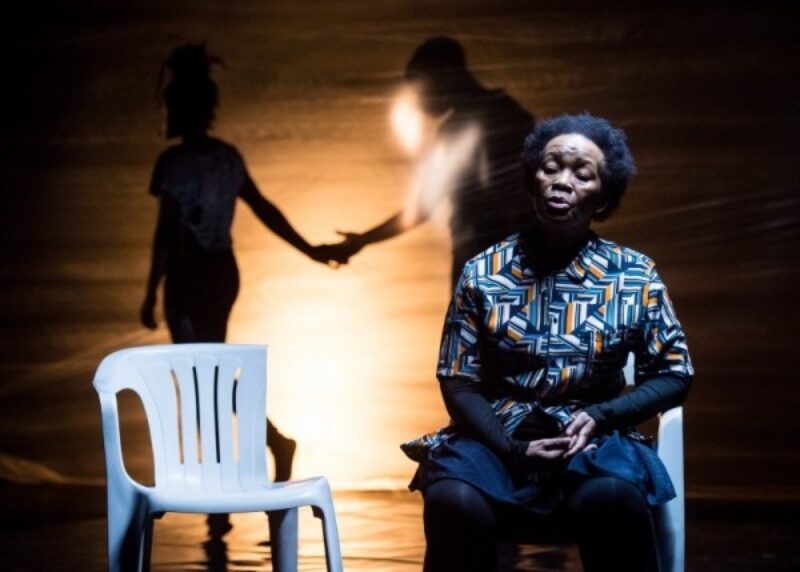A Coalition of the Arts
Written by TeenTix Press Corps Newsroom Writer Eleanor Cenname, and edited by Teen Editorial Staff Member Hannah Schoettmer!

And the show had begun. Four women on a stage. Crawling on the floor under a blanket. Furniture suspended from the ceiling. A layer of something called scrim. A topless woman. They are dancing. No, they are singing. No, they are talking. Are they sisters? Strangers? A mother and daughter? Wait, now it’s a show about Oprah. There is a pulsing noise in the background. Two scenes are happening at the same time. They are repeating an entire segment. From above, the furniture looks like a normal room. Some of the stage is flipped, so when actors are lying down and they are shown in a camera from above they look like they are sitting. They ripped the scrim. One of the women is wearing a glittery suit. They are playing with a light. The lights turn off and the show is over.
To say that Okwui Okpokwasili’s Poor People’s TV Room at On the Boards’ contemporary performance center was abstract may be an understatement; the show itself was a hypnotic, metaphoric emulsion of dance, song, monologue, and conversation. Describing the show is quite a burdensome task, as it was such a unique and shocking performance. The four women in the performance were made up of a multigenerational team of African and African American women. However, each performer was not a distinct character. Instead, the character each woman played fluctuated and changed until each woman was the other three women. Not only was the lack of distinct character a unique choice for the production, but the dancing was as well. The dancing was high energy and abstract, as some women danced alone and some danced with each other—though these partner and solo dances often happened at the same time of course.

Poor People's TV Room. Photo by Paul B. Goode.
The performance was a non-narrative presentation aiming to raise awareness for the 2014 kidnapping of almost three hundred young women by the Boko Haram: a militant extremist group. Additionally, the show strived to discuss and analyze the Women’s War of 1929, a protest in Nigeria organized by women to advocate for power in native courts. By non-narrative, I mean that this show had no distinct plot, or at least no plot typical of classic theater. Instead, Poor People’s TV Room left me questioning exactly what I had seen after the show itself.
This dancing style was not only unique, like the rest of the show, but it evoked powerful emotions and their own mood while they were dancing was also quite evident which made for an emotional performance. In the talkback with Okpokwasili after the performance, she revealed to have taken inspiration for the dancing from everyday actions of some women in parts of Africa. For example, when the dancers raised their arms above their heads, they were representing carrying goods and water. This metaphor made the performance not only a visually interesting dance, but a rich representation of what life can be like for women in certain parts of Africa. While their dancing and the sheer emotion evident through their movement elicited the everyday motion of the women in the story in a real and thought-provoking manner, their conversations on stage were so difficult to decipher it left me constantly scrambling during the performance. Often times, multiple conversations would occur simultaneously and they would repeat entire segments which made me feel more disoriented than captivated.

Poor People's TV Room. Photo by Ian Douglas.
Both the Women’s War of 1929, the Boko Haram kidnappings of 2014, and the resulting Bring Back Our Girls movement are each topics that should be discussed and reiterated through the medium of story. Poor People’s TV Room discussed these events, but the actual presentation was so abstract that finding a connection between these movements and the production was an equally abstract task, particularly with little knowledge on the Women’s War and kidnappings. I think that although the show may have been more difficult and in turn more abstract for viewers with limited knowledge, Poor People’s TV Room was still spreading the word about these events, which is an empowering message regardless of the viewer’s background knowledge. I understand that the show aimed to discuss these events that should still be remembered, though the abstract nature of the show combined with a niche subject matter made me feel more overwhelmed than curious in some segments.
The show seemed to be designed to evoke powerful emotions from the audience, with the at times shocking dancing, loud, pulsating music, and repetition of entire segments of the show. With such subject matter as the Women's War and Boko Haram kidnappings, powerful emotions are justified and despite its outlandish and abstract nature, the performance made for a memorable and thought-inducing experience that I will be hard pressed to forget.
The Teen Editorial Staff is made up of 5 teens who curate the review portion of the TeenTix blog and manage the TeenTix Newsroom. More information about the Teen Editorial Staff can be found HERE.
The TeenTix Press Corps promotes critical thinking, communication, and information literacy through criticism and journalism practice for teens. For more information about the Press Corps program see HERE.


